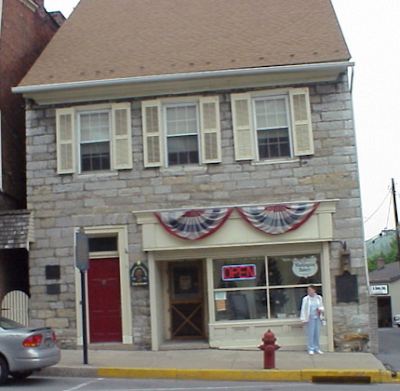Weather: Mostly Sunny, 52/74F
Route: From Cleveland 234 miles on I-77 S, I-76 E
Significance: Bedford was in the middle of one of the United States first crises. The Whiskey Rebellion occurred between 1791 and 1794. The basic upshot is the the U.S. government needed away to pay what it owed from the Revolutionary War - among several new taxes they decided to start taxing distilled spirits, of which whiskey was the most popular. All taxes on products had been up to that point on foreign goods - this was the first tax by the U.S. government on a product made by Americans that was sold to Americans.
This tax wasn't popular anywhere, but it was least popular in the western part of the United States. Kentucky, Tennessee and Georgia were the furthest western states at the time - and apparently were treated as a lost cause in terms of realistically collecting the tax. But as Philadelphia was the capital of the United States and the constitution was less than a decade old, the government, especially Alexander Hamilton thought that allowing citizens of Pennsylvania to get away with not paying the tax would make the government look weak.
The Whiskey Rebellion was actually somewhat organized. Up until 1794 their activities included tarring a feathering tax collectors, threatening farmers who were actually paying the tax, and in some cases even burning the barns of those who paid the tax. In July 1794, 500 hundred militia men attacked the house of General John Neville, a well known tax collector who was actually originally against the tax.
The rebels felt that in fighting against unfair taxation that they were continuing the spirit of the American Revolutionary War. They even recruited a former Revolutionary War General, James McFarlane to their cause. McFarlane led the 500 men against Neville, his slaves, and about 10 U.S. soldiers. McFarlane was killed in the battle, according to the rebels after raising a white flag and calling for a cease fire. McFarlane became a martyr for the cause and in August there was a gathering of 7,000 western Pennsylvanians who discussed going so far as to march to Pittsburgh - burn down the town and then secede from the United States.
The U.S. government decided that action was warranted. While they sent a group to negotiate, they organized a draft and marched 13,000 men under the command of President Washington (the only U.S. President to ever lead an army while he was President) to Western Pennsylvania. Washington stayed at a house in Bedford, PA (the Espy house), which still exists. So, that's where we are today. The site of a large federal military response to a group of people who refused to abide by the laws of the United States.
Washington and the Army's presence led to the end of organized rebellion in western Pennsylvania, however the rebels would have the last laugh as the Whiskey tax was repealed in 1801 when Thomas Jefferson became President.
I don't mean to suggest that the Whiskey rebels have anywhere close to the moral authority of the current Black Lives Matter protests which I firmly support - and the current protests have actually been much less violent than what the rebels did. However I think it is important to remember that from the very beginning our history is filled with stories of people who organized and at times violently protested what they believed were unfair circumstances or laws. We have already visited sites related to five other uprisings - Harpers Ferry, Prospect Bluff, Osawatomie, Wounded Knee and Matewan. It's hard to make any blanket statements about these insurrections - other than that no real changes happened without strong political movements that backed up the energy expressed by these actions. And that history is never boring and always relevant.
Image:
The Espy House in Bedford - where Washington stayed during the rebellion (from bedfordconnections.org)


No comments:
Post a Comment